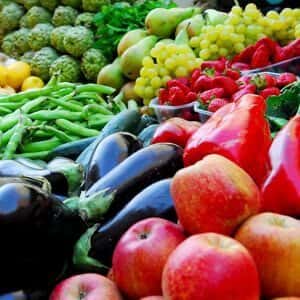
Most of us are not eating enough fruits and vegetables, according to the Centers for Disease Control and Prevention (CDC) (MMWR, online July 10, 2015).
How Much Fresh Produce Should You Eat?
The recommended intake is one and a half to two cups of fruit and two to three cups of vegetables daily for relatively sedentary people. More active individuals can and should eat more fresh produce.
The experts are especially interested in having people consume dark green and orange veggies. But only about 13 percent of American adults are getting the recommended amount.
Fresh produce consumption was lowest in southern states such as Mississippi (with only 5.5 percent getting the recommended servings of vegetables) and Tennessee (where only 7 percent ate the recommended amount of fruit). It was highest in California (17.7 percent for fruit and 13 percent for vegetables), but still nothing to brag about. These results indicate that there is plenty of room for improvement in the average American diet.
Can You Clean Produce Without Damaging It?
One reason people may be reluctant to consume fresh produce is the risk of eating vegetables or fruits contaminated with pathogens. That’s what has this reader worried:
Q. We hear so much about contaminated lettuce and other fresh raw vegetables causing illness. I recently heard that washing vegetables in hydrogen peroxide removes more bacterial organisms than other methods.
Is this true? I can’t find anything online about this concept.
A. Fruits and vegetables are sometimes contaminated with germs that can cause illness. The FDA encourages consumers to wash their produce under running water before eating. The agency notes that soap, detergent and commercial produce washes may leave a residue and it discourages their use.
What About Hydrogen Peroxide?
Hydrogen peroxide (H202) can also help against microbes. The FDA has approved its use in commercial applications.
We discourage using H202 purchased in the pharmacy, however. Instead, look for “food-grade” hydrogen peroxide at no greater than three percent. That can then be diluted (1/4 to ½ cup of H202 to a gallon of water). Soak the produce for 10 to 20 minutes and then rinse thoroughly with water and dry before using.
If you avoid fresh produce because it seems like too much trouble, consider using frozen vegetables. The nutritional quality is comparable. You can learn more about how to prepare vegetables so they are tasty and appealing in our book, Recipes & Remedies from The People’s Pharmacy.

